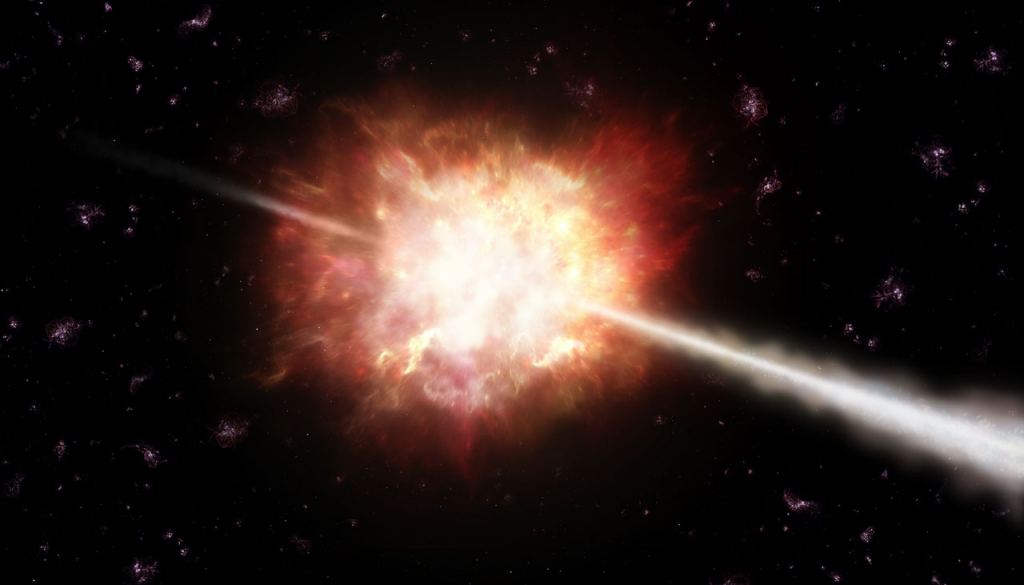We don’t really understand neutron stars. Oh, we know that they are – they’re the leftover remnants of some of the most massive stars in the universe – but revealing their inner workings is a little bit tricky, because the physics keeping them alive is only poorly understood.
But every once in a while two neutron stars smash together, and when they do they tend to blow up, spewing their quantum guts all over space. Depending on the internal structure and composition of the neutron stars, the “ejecta” (the polite scientific term for astronomical projectile vomit) will look different to us Earth-bound observers, giving us a gross but potentially powerful way to understand these exotic creatures.
Neutron Star Nougat
As you might have guessed it, neutron stars are made of neutrons. Well, mostly. They also have some protons swimming around inside of them, which is important for later so I hope you remember that.
Neutron stars are the leftover cores of some really big stars. When those giant stars near the end of their lives, they start fusing lighter elements into iron and nickel. The gravitational weight of the rest of the star continues to smash those atoms together, but those fusion reactions no longer produce excess energy, which means that nothing prevents the star from continuing to disastrously collapse in on itself.
In the core the pressures and densities become so extreme that random electrons get shoved inside protons, turning them into neutrons. Once this process completes (which takes less than a dozen minutes) this giant ball of neutrons finally has the wherewithal to resist further collapse. The rest of the star bounces off that newly-forged core and blows up in a beautiful supernova explosion, leaving behind the core: the neutron star.
Spirals Of Doom
So like I said, neutron stars are giant balls of neutrons, with tons of material (a few sun’s worth!) crammed into a volume no bigger than a city. As you might imagine, the interiors of these exotic creatures are strange, mysterious, and complex.
Do the neutrons bunch of into layers and form little structures? Are the deep interiors a thick soup of neutrons that just get stranger and stranger the deeper you go? Does that give way to even weirder stuff? What about nature of the crust – the outermost layer of packed electrons?
There are a lot of unanswered questions when it comes to neutron stars. But thankfully, nature gave us a way of peering inside them.

Minor downside: we have to wait for two neutron stars to collide before we get a chance to see what they’re made of. Do you remember GW170817? You actually do – it was the big discovery of gravitational waves emanating from two colliding neutron stars, along with a host of rapid-fire telescope followup observations across the electromagnetic spectrum.
All these simultaneous observations gave us the most complete picture yet of so-called kilonovas, or powerful bursts of energy and radiation from these extreme events. The particular episode of GW170817 was the only one ever caught with gravitational wave detectors, but certainly not the only one to happen in the universe.
A Neutron Hope
When neutron stars collide, things get messy really fast. What makes things especially messy is the small population of protons lurking around inside the mostly-neutron neutron star. Because of their positive charge and the super-fast rotation of the star itself, they’re able to create incredibly strong magnetic field (in some cases the most powerful magnetic fields in the entire universe) and those magnetic fields play some wicked games.

In the aftermath of a neutron star collision, the tattered remnants of the dead stars continue to swirl around each other in rapid orbit, with some of their entrails expanding away in a titanic blast wave, fueled by the energy of the crash.
The remaining swirling material quickly forms a disk, with that disk threaded by strong magnetic fields. And when strong magnetic fields find themselves inside rapidly-rotating disks, they start to fold in on themselves and amplify, becoming even stronger. Through a process not entirely understood (because the physics, like the scenario, gets a little messy) these magnetic fields wind themselves up near the center of the disk and funnel material out and away from the system altogether: a jet.
The jets, one at each pole, blast outwards, carrying radiation and particles far from the cosmic car accident. In a recent paper, researched investigated the formation and lifetime of the jet, looking especially carefully at how long it takes for a jet to form after the initial collision. It turns out that the details of the jet-launching mechanism depend on the interior contents of the original neutron stars: if you change how neutron stars are structured, you get difference collision stories and different signatures in the properties of the jets.
With more gruesome observations of kilonovas we might yet be able to discern some of these models, and learn what makes neutron stars really tick.
Read more: “Jet-cocoon outflows from neutron star mergers: structure, light curves, and fundamental physics“

